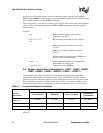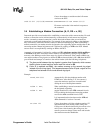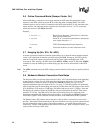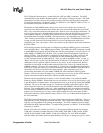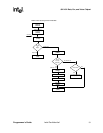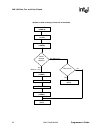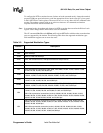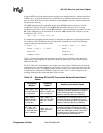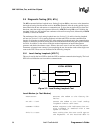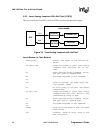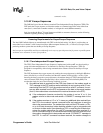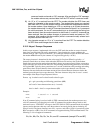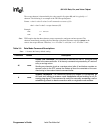
56K V.92 Data, Fax, and Voice Chipset
34 Intel Confidential Programmer’s Guide
The allowable connection modulations and data rates are determined by the +MS=m command,
which uses four parameters: <carrier>, <automode>, <min rate>, and <max rate>.
The +MS=m <carrier> parameter defines the top modulation rate.
The <automode> parameter determines whether the modem connection is allowed to fall down to
a lower modulation rate if the connection can not be made at a specified modulation or if the
modem connection can only take place at the specified modulation. Setting <automode> to 1
allows the modem to connect at a slower <carrier> type than that specified. Setting <automode> to
0 allows the connection to use only the specified <carrier> type.
The <min rate> parameter defines the lowest data rate at which a modem connection can take
place. Setting <min rate> to 0 has one of two meanings depending on the <automode> setting.
When both <automode> and <min rate> are set to 0, then the lowest data rate at which the
connection can take place is the lowest data rate specified by the <carrier> parameter. If
<automode> is set to 1 and <min rate> is set to 0, then the lowest data rate is 300 bps.
The <max rate> parameter defines the highest data rate at which a modem connection can take
place. If the <max rate> is set to 0, the modem uses the DTE data rate or a slower <carrier> data
rate as the highest permitted connection data rate. This highest-permitted data rate means the
modem attempts to connect at this data rate but may connect at a slower rate because of line
impairment. If <max rate> and <automode> are set to 0 and the DTE data rate is below the lowest
data rate supported by the modulation rate, then the modem’s connection attempts always fail, and
the modem reports a “NO CARRIER” message.
If the +MS=m parameters contain conflicting information like “+MS=V34,1,14400,0” with a DTE
data rate of 2400 bps, then the modem’s connection attempts always fail, and the modem reports a
“NO CARRIER” message. This happens for two reasons. First, when the modem receives the
+MS=m command, the modem does not check for conflicts of valid parameter information.
Secondly, some of the same configuration information is provided by two other commands: Nn and
S37. The command issued last takes precedence.
The Nn command specifies whether the modem should attempt to establish a connection using a
single modulation type or allow the connection to fall to a lower modulation type. Nn performs the
same function as the +MS=m <automode> parameter. Whatever command is issued last
configures the modem for any following connections. Thus, upon receiving the +MS=m command,
the modem changes the value for Nn.
When configured to N0, the modem only attempts a connection at the <carrier> rate specified by
S37, +MS=m, and Bn. If the remote modem does not support any of the <carrier> data rates, the
modem does not achieve a connection and responds back with a “NO CARRIER” message.
When configured to N1, the modem attempts to connect to the remote modem at the highest speed,
as defined by S37, +MS=m, and Bn. Since not all modems support (or are configured for) the same
modem-to-modem data rates, the modems may connect at a lower speed.
+MS = <carrier >, <automode>, <min rate>, <max rate>
same as
Nn
same as
S37



